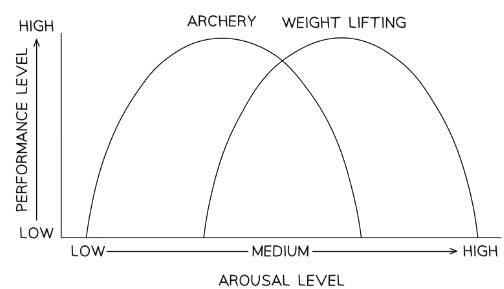Year 11 Exam > Year 11 Notes > Physical Education for GCSE/IGCSE > Definition of Arousal
Definition of Arousal | Physical Education for GCSE/IGCSE - Year 11 PDF Download
Overview
Arousal refers to:
- A condition of physical and psychological stimulation
- The arousal state exists on a spectrum, ranging from deep sleep (minimal arousal) to extreme excitement (elevated arousal)
- Arousal influences both the physical capabilities and mental condition of an athlete
- The mental condition encompasses both physiological and psychological aspects of an individual
- Physical manifestations of heightened arousal include elevated heart rate and perspiration
- Managing arousal levels is essential to prevent negative impacts on performance
Inverted-U Theory
- The inverted-U theory illustrates the connection between arousal and performance.
- The term 'inverted-U' derives from the graph’s shape that represents the theory.
- The inverted-U graph indicates:
- Performance improves as arousal rises, reaching an optimal level.
- Beyond the optimal arousal point, performance declines.
- Insufficient arousal can result in poor performance in a sporting activity or skill, possibly due to lack of focus or boredom.
- Excessive arousal can also cause reduced performance, often linked to elevated stress or anxiety.
Optimal Arousal Levels in Sport
Optimal arousal levels vary depending on the specific activities or skills performed.For example:
- Sports that demand precise movements and fine skills, such as targeting in archery, require lower arousal levels, resulting in a lower optimal arousal point.
- Activities involving gross skills that demand high power and energy, like weightlifting, necessitate higher arousal levels, leading to a higher optimal arousal point.
Diagram of inverted-U theory graph
 The optimal levels of arousal are different for different activities
The optimal levels of arousal are different for different activities
The document Definition of Arousal | Physical Education for GCSE/IGCSE - Year 11 is a part of the Year 11 Course Physical Education for GCSE/IGCSE.
All you need of Year 11 at this link: Year 11
|
99 docs|6 tests
|
FAQs on Definition of Arousal - Physical Education for GCSE/IGCSE - Year 11
| 1. What is the Inverted-U Theory and how does it relate to optimal arousal levels in sports? |  |
Ans. The Inverted-U Theory suggests that there is an optimal level of arousal for peak performance in sports. According to this theory, performance increases with arousal up to a certain point, after which it begins to decline. This means that athletes must find their individual optimal arousal level to achieve the best results, balancing between being too relaxed and too anxious.
| 2. How is arousal defined in the context of sports psychology? |  |
Ans. In sports psychology, arousal refers to a state of alertness, readiness, and activation of the body and mind. It is characterized by physiological responses such as increased heart rate and heightened sensory awareness. Arousal can significantly impact an athlete's performance, influencing their focus, energy levels, and overall effectiveness during an event.
| 3. What factors can influence an athlete's optimal arousal level? |  |
Ans. Several factors can influence an athlete's optimal arousal level, including the type of sport, the specific demands of the competition, individual personality traits, and previous experiences. For instance, high-pressure situations may require different levels of arousal depending on whether the athlete thrives under pressure or prefers a calmer approach.
| 4. Can arousal levels be managed or altered to improve sports performance? |  |
Ans. Yes, athletes can manage and alter their arousal levels through various techniques. Strategies such as visualization, breathing exercises, and mindfulness can help regulate arousal. For instance, deep breathing can lower arousal levels when an athlete feels too anxious, while energizing music might boost arousal when they feel too relaxed.
| 5. Why is understanding optimal arousal levels important for coaches and athletes? |  |
Ans. Understanding optimal arousal levels is crucial for coaches and athletes because it helps in designing effective training regimens and competition strategies. By recognizing how arousal affects performance, coaches can tailor their approach to each athlete's needs, enhancing their chances of success and improving overall performance during competitions.
Related Searches




















